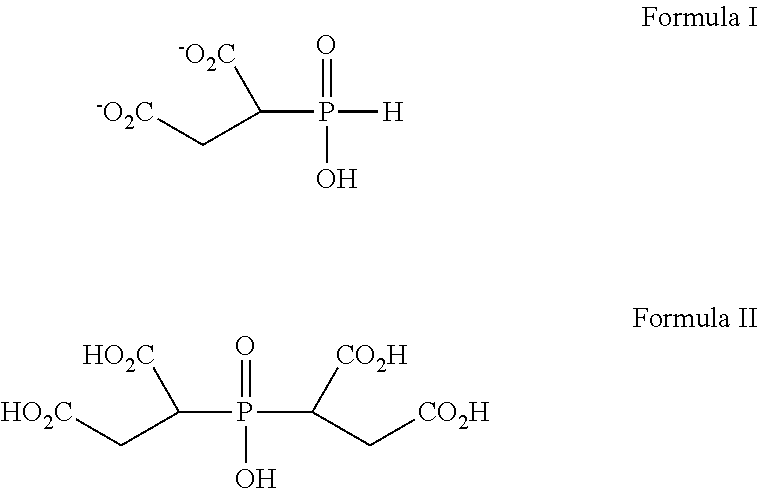Method of inhibiting scale formation and deposition in desalination systems
a scale and desalination system technology, applied in the direction of water/sewage treatment by ion exchange, chemistry apparatus and processes, separation processes, etc., can solve the problems of scale formation and deposition is a significant problem, cale creates thermal and mechanical problems, is sometimes difficult to remove, etc., to increase distillate and/or permeate recovery, the effect of inhibiting scale formation and deposition
- Summary
- Abstract
- Description
- Claims
- Application Information
AI Technical Summary
Benefits of technology
Problems solved by technology
Method used
Image
Examples
example 1
[0045]A 2.1:1 molar ratio of fumaric acid to hypophosphite was used in this Example. Crushed maleic anhydride briquettes, 75.9 parts, were added to 104.4 parts water in a 1 liter resin flask equipped with a mechanical stirrer, condenser, nitrogen inlet, and heater. The anhydride was allowed to hydrolyze at 40° C. to produce a maleic acid solution. The reaction was then heated to 60° C. and a solution of sodium bromide (0.16 parts dissolved in 0.20 parts water) was added, followed immediately by a solution of ammonium persulfate (0.43 parts dissolved in 1.49 parts water). Within 60 minutes, an exothermic reaction converted the maleic acid solution into 183.6 parts of a 49.2 wt. % slurry of fumaric acid in water, as verified by proton NMR.
[0046]Sodium hypophosphite monohydrate (38.9 parts) was added to 182.6 parts of a 49.2 wt. % slurry of fumaric acid in water contained in a 1 liter resin flask having a mechanical stirrer, condenser, nitrogen inlet, and heater. A solution of ammonium...
example 2
[0048]A 2.5:1 molar ratio of fumaric to hypophosphite was used in this Example. The reaction conditions were as described in Example 1. The product, including salts of hypophosphite / fumarate adducts described in Table 2 below, displays the following molar distribution of components as determined by phosphorous NMR analysis.
TABLE 2ComponentMole PercentPhosphinicobis(succinic acid) salts (Structure II)49Phosphinicosuccinic acid salts (Structure I)7Phosphonosuccinic acid salts3Phosphinicosuccinic acid oligomer salts (Structure III)38Hypophosphite, phosphite, and phosphate salts
example 3
[0049]This is a comparative example, which used maleic acid instead of fumaric acid at the same 2.5:1 molar ratio as Example 2. It demonstrates that the results obtained with fumaric acid are unanticipated. The first dataset represents results obtained in the lab using the general procedure above, and the second dataset represents a plant run using the same mole ratio maleic to fumaric.
[0050]The general reaction conditions described in Example 1 were repeated except that maleic acid was substituted for fumaric acid at the same molar concentration. The product, comprised of salts of hypophosphite / maleate adducts described in Table 3 below, displayed the following molar distribution of components determined by phosphorous NMR analysis.
TABLE 3ComponentMole PercentPhosphinicobis(succinic acid) salts (Structure II)22, 17Phosphinicosuccinic acid salts (Structure II)24, 22Phosphonosuccinic acid salts 2, 12Phosphinicosuccinic acid oligomer salts (Structure III)43, 35Hypophosphite, phosphite...
PUM
 Login to View More
Login to View More Abstract
Description
Claims
Application Information
 Login to View More
Login to View More - R&D
- Intellectual Property
- Life Sciences
- Materials
- Tech Scout
- Unparalleled Data Quality
- Higher Quality Content
- 60% Fewer Hallucinations
Browse by: Latest US Patents, China's latest patents, Technical Efficacy Thesaurus, Application Domain, Technology Topic, Popular Technical Reports.
© 2025 PatSnap. All rights reserved.Legal|Privacy policy|Modern Slavery Act Transparency Statement|Sitemap|About US| Contact US: help@patsnap.com

